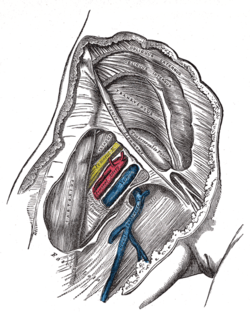Fascia transversalis
| Transverse fascia | |
|---|---|

The abdominal inguinal ring. ("Fascia transversalis" visible near center.)
|
|

Femoral sheath laid open to show its three compartments.
|
|
| Details | |
| Identifiers | |
| Latin | fascia transversalis |
| Dorlands /Elsevier |
f_03/12355646 |
| TA | A04.5.02.011 |
| FMA | 12265 |
|
Anatomical terminology
[]
|
|
The transverse fascia (or transversalis fascia) is a thin aponeurotic membrane which lies between the inner surface of the transverse abdominal muscle and the parietal peritoneum.
It forms part of the general layer of fascia lining the abdominal parietes, and is directly continuous with the iliac fascia, internal spermatic, and pelvic fasciae.
In the inguinal region, the transverse fascia is thick and dense in structure and is joined by fibers from the aponeurosis of the transverse abdominal. It becomes thin as it ascends to the diaphragm and blends with the fascia covering the under surface of this muscle.
Behind, it is lost in the fat which covers the posterior surfaces of the kidneys.
Below, it has the following attachments: posteriorly, to the whole length of the iliac crest, between the attachments of the transverse abdominal and Iliacus; between the anterior superior iliac spine and the femoral vessels it is connected to the posterior margin of the inguinal ligament, and is there continuous with the iliac fascia.
Medial to the femoral vessels it is thin and attached to the pubis and pectineal line, behind the inguinal falx, with which it is united; it descends in front of the femoral vessels to form the anterior wall of the femoral sheath.
...
Wikipedia
